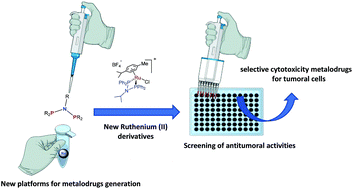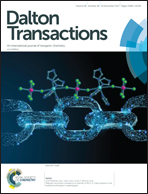Aminophosphine ligands as a privileged platform for development of antitumoral ruthenium(ii) arene complexes†
Abstract
The rapid and modular synthesis of the aminophosphine core has been exploited as a tool for rapid development of antitumoral metallodrug candidates. Starting with a series of structurally diverse aminophosphines, all obtained in a single step from commercial amines, a family of Ru(II)–cymene complexes have been generated and tested in vitro for anti-tumoral activity in a series of cell lines, including the platinum-resistant A2780R. Through this approach, Ru(II)-aminophosphine complexes have been identified with the IC50 value range as low as 10–0.8 μM. Several biological assays were carried out to gain insight into the mechanism of action. Cell death by apoptosis and pH-independent action has been demonstrated. In addition, a selective cytotoxicity profile for tumoral cells over non-tumoral cells has been identified. Importantly, for the key candidates no loss of activity was observed when applied to the Pt-resistant A2780R, which highlights the potential utility of the bis-phospinoamine scaffold as an easily-tunable auxiliary ligand core in both drug discovery and subsequently a logical design of new anticancer metal-containing drugs. The complexes are characterised by NMR spectroscopy, mass spectrometry and single-crystal X-ray diffraction.



 Please wait while we load your content...
Please wait while we load your content...